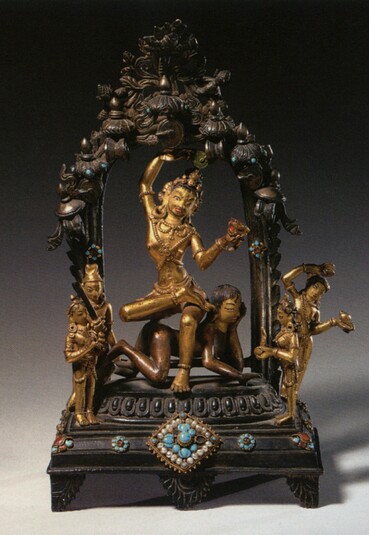
Item: Indian Adept (siddha) - Krishnacharya
| Origin Location | Tibet |
|---|---|
| Lineages | Buddhist |
| Material | Metal |
| Collection | Private |
Krishnacharya, Mahasiddha: the Indian master of Tantric methods from the group of Eighty-four famous mahasiddhas according to the system of Abhayadatta. The iconography of the siddha is likely based on a text originating in the Jonang Tradition and then continued by Jonang Taranata in the late 16th and early 17th century. We see similar depictions in painting of the mahasiddha in the same iconographic appearance. These later works were commissioned by Situ Panchen in the 18th century following the texts of Jonang Monastery (see example middle right side).
Krishnacharya is included in several of the five main lists of Eighty-four Mahasiddhas, Buddhist Tantric Adepts of India, although not always by the same name. He is often referred to as Charya or Charyapa. He is also confused and conflated with the other mahasiddhas known as Krishna, Kanha and Kanhapa.
Krishnacharya was an Indian Buddhist practitioner that is generally depicted in Siddha, or Mahasiddha Appearance. As a sign of his attainments he is described as having seven parasols and seven drums floating in the sky above his head. As a mount he is seated atop an animated corpse or zombie. He is known in literature for being surrounded by five hundred yogis and yoginis - this however is not typical in painting and sculpture.
The sculpture clearly shows seven double hand drums above the head of the siddha along with seven parasols. Four attendant figures stand to the right and left holding a variety of objects in the right and left hands.
Jalandara was the main teacher of Krishnacharya and their principal practices were the Chakrasamvara, Hevajra and Mahamaya Tantras. There are three most famous traditions of Chakrasamvara in Tibet known as the 'Lu Nag Dril Sum' which refers to the three important lineage teachers Luipa, Krishnacharya and Ghantapa.
The throne is raised up with legs reminiscent of the old Eastern Indian style that preferred legs beneath sculpture. The square throne tapers upwards and is topped with a single blossoming lotus flower serving as the platform for Krishnacharya seated atop his animated mount. Pearls, turquoise and glass beads adorn the base and less so up the sides of the torana.
There are several biographies of Krishnacharya with the longest and most detailed written by Jonang Taranata who believed that he himself was the re-incarnation of the mahasiddha (see incarnation lineage).
Jeff Watt 7-2015
Sculpture: Figurative Subjects, Bases with Legs
Sculpture: Figurative Subjects, Lotus & Throne Base
Collection: Christie's, Sculpture (September, 2005; NY)
Sculpture: Figurative Subjects, Base (Throne & Cushion)
Indian Adept: Krishnacharya



